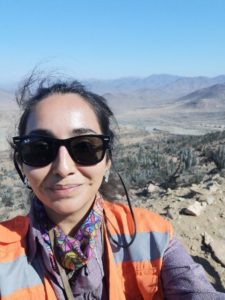Over the next few weeks, we’d like to introduce you to some new faces on the GfGD blog, bringing fresh ideas and perspectives on topics relating to geoscience and sustainable development. We’re delighted to have their input and look forward to their posts. Today we interview Olivia Mejías – a project geologist currently researching critical metals in Chile at the Sustainable Minerals Institute – International Centre of Excellence in Chile (SMI-ICE-Chile).
 Tell us about you and your work and interests.
Tell us about you and your work and interests.
My name is Olivia Mejías, a Chilean geologist with a master’s degree in applied mineralogy specialized in geometallurgy. I’m delighted to be volunteering for GfGD.
I’m currently working as a project geologist at Sustainable Minerals Institute – International Centre of Excellence of The University of Queensland, based in Santiago, Chile. My current work is part of the Complex Ore Bodies Program; I’m assessing critical metals hosted in iron oxide-copper-gold (IOCG) deposits in northern Chile.
Previously, I worked on short-term geometallurgy and production geology at a world-class copper-molybdenum porphyry underground mine for nearly seven years. Since 2019, I am part of the Technical Committee of the International Conference on Geometallurgy (GEOMET) that takes place in Chile.
I’m enthusiastic about mine waste management based on a circular economy (especially the science behind it!), and its contribution to some of the United Nations Sustainable Development Goals (SDGs). Recently, I saw the opportunity to get involved with GfGD as a science communicator. It is a wonderful opportunity to expand my networking worldwide according to the relationship between geosciences and SDGs.
I’m passionate about travelling, doing outdoor activities and interacting with different cultures on each trip. I love to spend time with my cat, listen to different podcasts about science and society, as well as making embroidery, mixing watercolour and acrylic paints, and doing yoga.
Each geographical region considers different raw materials to be critical
What are critical metals and why are they critical?.
As society evolves according to the demand for the development of digital technologies and renewable energy, the number of elements as a raw material has grown to cover almost the entire periodic table. For instance, electromobility (cobalt, lithium, Rare Earth Elements or REE), solar panels (tellurium, indium, gallium), wind turbines (REE, cobalt), smartphones (indium, REE, gallium) are examples of devices that use critical metals because of their very specific functional properties.
Critical metals are economically important for the development of technology and sustainability in our society; however, they have a high potential for supply disruption. These are critical because there is an insufficient supply in comparison to other elements. There are a few mines or even countries that hold large resource deposits of critical minerals.
Each geographical region considers different raw materials to be critical. For this reason, sometimes you can see a different list of critical metals for the European Union in contrast to the United States or Australia. Some critical metals that have been declared by them are cobalt, REE, gallium, germanium, indium, vanadium.
Tailings can present environmental risks requiring ongoing management, but […] they could also be potential resources
What is the perspective of Chile on sustainable minerals?
Chile has a long history in the extraction of mining resources, such as copper, iron, gold, and molybdenum. Particularly, our nation produces about one-third of the world’s copper. Currently, the challenge is to direct and extend this knowledge towards critical metals and sustainable mining. The Chilean Mining Technological Roadmap (2015-2035) includes eight topics, here I would like to emphasize two of them: Green Mining and Tailings.
These two topics allow progress towards the circular economy in the mining industry. Tailings can present environmental risks requiring ongoing management, but as a supply solution, they could also be potential resources helping supplement the demand for critical metals. In this case, the Chilean Mining Roadmap states the necessity for Chile to reprocess tailings deposits and recover critical metals from them, at least four research programs are currently evaluating some tailings deposits and looking for options of recovery.
I am a fervent believer that the geosciences have an essential role in achieving compliance with the SDGs. One of these ways is by extracting critical minerals needed for green technologies sustainably, either as main commodities or as by-products from primary and secondary deposits. Here in Chile, we have a huge opportunity in this field due to the vast experience in extracting resources.
How did you come across GfGD, and why do you want to engage in our work?
In April I saw a poster called “Geoscience for the Future” by The Geological Society of London on LinkedIn. When I reviewed the poster, it is was really inspiring to me to see how each area in the geosciences has a role in contributing to achieving the SDGs, and how all of them are part of a big value chain.
At the same time, I noticed that GfGD is another organization involved in this and I decided to write to the team. Furthermore, my doctoral research will be on transforming mine waste into green ore deposits through the exploration of new economic metals, so undoubtedly the GfGD aligns well with my own interests, and I’m delighted to have this opportunity to contribute.
What themes/topics are you interested in and may like to write about in the future?
I love having the opportunity to write for different audiences. I’m happy to communicate passionately about tailings, critical metals, geological heritage, sustainable mining, and other examples of how geosciences have a relationship with achieving compliance with the SDGs. Of course, I would like to share this information related to aspects of the geology in Chile and some advancements related to SGDs.
Olivia tweets @MejiasOlivia
